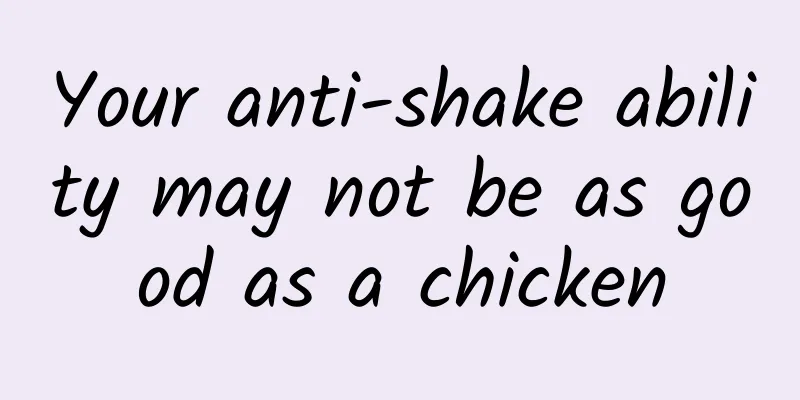Your anti-shake ability may not be as good as a chicken

|
Produced by: Science Popularization China Author: Guo Fei Yantai University Producer: China Science Expo A few years ago, a car brand used a chicken to shoot an advertisement to show that its cars had the same stability as a chicken head. After that, many short videos related to the magical stability of the chicken head kept appearing on major video websites. From these, we can see that the effect of the chicken head stabilizer is simply "enterprise-level". Whether it is fixed-point, accompanying, or autonomous movement, it is not inferior to the most advanced human technology, so much so that some people abroad have even developed a set of head-mounted camera equipment specifically for chickens. It's a pity that the existing technology cannot control the direction of the chicken's head, which makes the funny attribute of "Chicken Cloud Platform" infinitely greater than its technological attribute. GIF: Just don’t move! (Video source: SmarterEveryDay) To be honest, the chicken's head is really "stable". So the question is, why is the chicken's head so stable? Can the heads of other birds be so stable? 1. Birds’ extraordinary talents The stability of the chicken head is mainly reflected in two aspects. First, when the body is fixed and does not move, no matter how you shake them, the head always tends to be fixed at a certain point in space. Second, if you put a portable camera on the chicken and let it walk freely, you will find that the picture taken is relatively stable (of course, we cannot control the sudden turn of the chicken's head). The chicken head can have such a special ability, first of all thanks to the flexible neck from the perspective of body structure. Birds generally have 13 or 14 cervical vertebrae, far more than most mammals including humans (7 vertebrae). Some birds even have 25 cervical vertebrae (such as swans). This also allows the bird's head to move freely in a sphere with the last cervical vertebra as the center and the length of the neck as the radius (except for the torso, of course). Many birds' heads can even rotate nearly 360° (180° left and right). Typical pigeon skeleton (Image source: Wikipedia (left)) However, the flexible neck only means that the chicken's head can be locked in place, and it does not explain why the chicken locks in place. In fact, the chicken's behavior itself is just to see the surrounding scenery as clearly as possible , or it is an instinct to see the scenery clearly. Specifically, chickens, like most birds, have a high eyeball-to-head ratio and a well-developed visual system. They not only have good vision, but also a large area of the brain that processes vision-related signals. Unfortunately, however, the mobility of birds’ eyes is very limited (the specific reasons will be discussed in detail later). Human eyes can move flexibly in their eye sockets, and with the head completely still, the best field of vision for both eyes can reach a 120° cone in the front. However, the range of motion of birds' eyes in their eye sockets is very limited, so in most cases, if birds want to see objects moving in front of them with the best field of vision, they can only do so by twisting their necks instead of rotating their eyeballs. It should be noted here that the so-called optimal field of view refers to a small area with the highest visual resolution . For example, when the human eye looks straight ahead, the overall field of view can reach more than 180°, but the optimal field of view is only a small area where the line of sight is concentrated (about 40°). Outside this area, human vision will actually decay rapidly. Comparison of bird vision ranges, Image source: self-made by the author The above picture is a comparison of the visual range of the horned owl and the fan-tailed sand cone. It can be seen that the raptor (the former) has well-developed forward binocular stereo vision and weak backward vision. Ordinary birds have well-developed omnidirectional vision, but poor forward binocular stereo vision. The two eyes of a chicken are located on both sides of its head, so its binocular vision is very poor. However, the eyes on both sides can each provide a 180° field of view, giving the chicken almost a 300° visual range. But the range of binocular vision in front of their field of vision may be less than 5°. The most sensitive area of vision for most birds, except for birds of prey, is near the center of the eyeballs on both sides. At the same time, the binocular vision area in front is also an area where birds have relatively good vision - in short, birds can see objects in front and in the middle of both sides at the same time. 2. Eye movement or head movement? This is a practical question Now suppose we put a stationary object in front of us, and ask us to keep our eyes on it while moving our bodies slightly. What would we do? Of course, we would move our eyes so that the best view would not deviate from the object due to the movement of our bodies. When we repeat the above experiment with chickens, in order to see the object in front of them clearly, the chickens will try to keep their heads fixed and use their flexible necks to compensate for the displacement of their bodies. It is obviously easier to see a still object than a moving object, but movement is relative. Sometimes it is not the object in front of us that is moving, but our body itself. Whether it is an object or a body that is moving, when the movement is not large, humans do not need to turn their heads or turn around to look at the target they want to see, they just need to move their eyeballs. Chickens cannot move their eyeballs very well, but their necks are flexible, so they do not need to adjust the body's position, they just need to move their necks. Many people may ask, if you want the chicken head to achieve positioning, do you have to put a fixed target in front of them for them to stare at? This is not necessarily the case. It does not necessarily have to be a specific object. The field of vision of the chicken head itself is the picture that the chicken wants to see clearly at this time. In order to make this picture fixed and see it more clearly, the chicken naturally uses its flexible neck. As a result, the head and the body did not move, only the neck moved. 3. Chickens stretch their necks when they walk, which is actually a visual enhancement method Next, let's see if the chicken's head can be so stable when the chicken is walking. The picture taken by the chicken's head-mounted camera shows that the picture taken by the chicken's head is quite stable even when it is walking, at least far exceeding the level of human handheld camera equipment without a gimbal. Humans have two legs, chickens also have two legs, and they are all bipedal animals, but the results are very different. In fact, if you pay attention to the walking posture of chickens or pigeons, you will find that they do not keep their upper body and neck still and take turns to step forward, but their necks are constantly stretching and retracting. This unique walking posture is the reason why the head-mounted camera of the chicken can ensure stable images even when it is in motion. It is still closely related to the visual formation mechanism of the chicken. Zoologists began to study the scientific issues behind the walking posture of chickens or pigeons about fifty years ago. They used several very clever experiments to prove the close relationship between vision and gait. For example, scientists let pigeons walk on a treadmill. At this time, the scenery in the pigeon's field of vision does not actually change, only the feet are moving. At this point, an interesting phenomenon occurs: the pigeons keep their bodies and necks still while walking. In another experiment, chickens walking in infrared cameras also keep their necks still if they are in a dark room where their eyes cannot sense light. Later, with the development of human imaging science, the software and hardware related to cameras and video processing quickly became popular, and more and more people conducted similar research. People found that when chickens and pigeons walk, the neck is the first part to reach forward. The neck stretches in front of the body. After the head is relatively fixed, the two feet will each reach out one step. When the two feet take a step, the head is almost still. After that, the head reaches forward again, and then repeats. When the head is forward, the eyes are in motion, which is not an ideal visual condition. Therefore, the rapid forward movement of the head does not take up a large proportion of the entire movement period. After the head is forwarded, it is equivalent to waiting for the body in front, and can remain relatively still under the adjustment of the neck while the body catches up. This process is visually stable and takes up a longer period of time during the entire movement. Slow motion animation of pigeon gait (Photo credit: taken by the author) The above experiments show that the reason why chickens or pigeons adopt a walking posture with their necks constantly moving back and forth is to better see the surrounding scenery, or to make the time to see the surrounding scenery clearly as long as possible and the time to see unclearly as short as possible. From the perspective of animal behavior, the underlying reason for this behavior is to ensure the best vision for a long enough time under the premise of minimizing energy consumption. Once the vision is already good (such as a walking machine) or nothing can be seen (such as a dark room), pigeons and chickens do not need to adopt this gait specifically. 4. Can other birds also transform into gimbals like chickens? Then the question arises, do birds other than pigeons and chickens have the same behavior? Yes and no. Using the neck as a gimbal to compensate for the body's movement when the head is still is a common behavior among birds . However, not all birds will adopt the gait of pigeons and chickens. The reason behind this is a very profound scientific question, and we will only make some qualitative explanations. A variety of birds (Image source: Wikipedia) Let's talk about the neck gimbal first. In fact, not only chickens, but all birds will show this behavior to some extent. For example, a kingfisher standing on a branch in the wind, although the branch keeps shaking, the kingfisher's head remains motionless. From an evolutionary perspective, how should we understand this habit of birds? As mentioned above, flexible necks are a gift of birds, while inflexible eyes are a defect of birds. Why haven't birds' eyes evolved to be as flexible? Birds are naturally adapted to flying in groups, and flying requires the lightest possible weight and the most streamlined body. Therefore, a huge head with hippopotamus-like proportions obviously does not meet the dynamic requirements of flying. At the same time, flying requires good eyesight, so birds have relatively developed vision, and their eyes take up a lot of space on their heads. Many other species with excellent eyesight have precise and flexible eyeballs, such as chameleons, whose two eyes can rotate independently. But such high-end large eyes must require a large number of eye movement muscles and sufficient space layout to support them, so the chameleon's eyeballs actually protrude from the surface of the head. But for birds, not to mention that the smaller head has nowhere to place such a luxurious configuration, the protruding eye sockets and eyeballs will also form resistance during flight. The chameleon's eyes are independent and can be freely turned to different perspectives. Image source: Wikipedia In addition, birds also have very developed scleral rings, which are a group of hard structures around the eyes that protect the eyeballs like armor. Birds are affected by wind pressure during flight, and the eyeballs will be compressed and deformed to a certain extent. The existence of scleral rings can keep the bird's eyeballs in their original shape, thereby better ensuring vision during flight. However, the existence of this armor also further reduces the flexibility of the bird's eyeballs. The skulls and scleral rings of several raptors are shown (Photo credit: taken by the author) Therefore, although birds' eyes are well developed, they are too integrated and specialized, which means that they have to reduce their functions in some aspects. Therefore, birds' necks become more and more flexible to offset the loss of the eyeball's poor mobility. The nictitating membrane of the white-necked lapwing (another adaptation of the bird's eye for flight) Image source: Wikipedia 5. Birds’ gaits are complex and varied, but the reason behind them is simple As for the gait of birds, we can also look for the answer from evolution. In reality, birds have diverse gaits. In addition to pigeons and chickens that stretch their heads forward and backward, small birds often hop on both feet, while ducks sway left and right by tapping their feet alternately. After reading the gait analysis of pigeons and chickens, many people may ask, don’t other birds need to keep their vision clear for as long as possible? The answer is of course they do, but it must be noted that the body shapes and habits of birds vary greatly, so it cannot be generalized. For example, small and light birds, although their jumping walking style will make it difficult for their eyes to see surrounding objects clearly during the flight. But they are light in body, and their jumping style is swift and energy-saving. When they need to observe, they can stop and observe, and after determining the target, they can quickly move forward, which is very efficient in the end. Chickens and pigeons often forage on the ground, and they are restricted by their body size and cannot "flash" like birds, so it is better to just walk and watch so that they can find food at any time. As for wild ducks, they are waterfowl themselves, and walking on the road to forage is not a rigid need, so their walking posture is sloppy, and their two feet can quickly get into the water by tossing back and forth. Mallard duck (Image source: Wikipedia) Wading birds such as cranes also live and forage in water, but in order to observe the surroundings as efficiently as possible, their walking posture when foraging is the same as that of chickens and pigeons. When walking normally, red-billed gulls only use two feet at a time, and there is no additional forward and backward movement of the neck. But when they need to find food, they will also stretch their necks forward. In addition, some birds that need to dive into the water to catch fish will even adopt a swimming posture in the water with their heads forward and their bodies following. Their intention is still to see the surrounding environment as clearly as possible for as long as possible. Adult black-headed gulls in summer (left) and winter (right) Image source: Wikipedia entry for Red-headed Gull Of course, the walking posture of birds is not only related to their habits, foraging methods, and body shape, but also requires consideration of factors such as maintaining a sense of balance. It is not a problem that can be simply summarized. Birds have chosen an evolutionary path that suits them, and eventually they have successfully taken over the skies. The stability of the chicken head and the gait of birds are both influenced by evolution. When we encounter birds in the future, we might as well pay attention to their steps and analyze the reasons for their steps based on their habits and body shape. If we think about it carefully, there is a lot of fun in it! References: 1. Illustration of the skeletal system (Skeletal system) Vertebrates 2. Animal eyes and vision http://www2.tbb.t-com.ne.jp/mark/siya.html 3. Dogs and birds are the same as humans in the world, and are they seen in the same way? ~その1「Vision」~ https://ist-ud.iseto.co.jp/?p=1385 4. Horizontal viewing angle https://style.nikkei.com/article/DGXNASDG06030_W3A101C1000000 5. What is the world of birds and birds? The functions of the human eye are astonishing https://logmi.jp/business/articles/157552 6. ハトはなぜ头を真りながら歩くのか? https://epinesis.net/archives/69560457.html |
>>: World Mosquito Day丨Take it, no thanks! These methods can make mosquitoes "extinct"
Recommend
When driverless driving becomes a risk in Tesla's eyes, can cars really say goodbye to steering wheels in three years?
Not long ago, Tesla CEO Elon Musk posted a messag...
How to rent a server cabinet?
How to rent a server cabinet? The rental of a ser...
Summary of Android's dominant control View
[[163808]] About Android View Controls Controls i...
Dating requires IQ, staying up late will make people stupid
One minute with the doctor, the postures are cons...
Do you know about the top 10 most popular fission marketing?
The article breaks down the top ten most popular ...
Huang Jue's personal profile: What is Baidu's Ice Bucket Algorithm and what impact does it have on SEO?
It is an indisputable fact that the Internet has ...
Fun fact: Why don’t herbivores eat meat?
I recently saw an interesting question. A netizen...
How to find the lever to leverage traffic dividends?
The so-called traffic means acquiring new users. ...
Search promotion strategy for the tourism industry!
1. Industry Overview In the past, travel was a sy...
Advertising landing page optimization rules!
We all know that the key to a landing page is tha...
[Smart Farmers] Uncovering the scientific secrets of corn harvest: "Dense Planting, High Yield and Precision Control Technology"
Corn is an important food, feed and industrial ra...
I have a P2P platform promotion secret book worth millions. Would you mind sharing it with me?
1. Secret of magic skill: one pain point + three ...
Many people make mistakes when uninstalling mobile phone software. Only by doing this can the software be deleted cleanly.
Everyone will increase the space and memory of th...
Is producing content a process of draining yourself? Where will content startup unicorns emerge?
Your words, your knowledge, your voice, your look...









